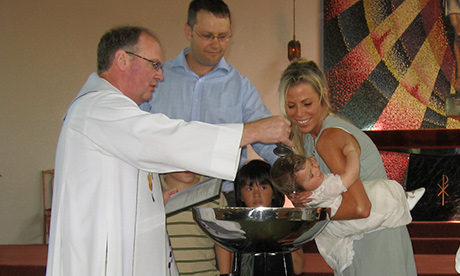Fr Matthew Hood of the Archdiocese of Detroit recently discovered that his baptism as an infant had been invalid when he watched a family video that showed Deacon Mark Springer saying, “We baptize you in the name of the Father, and of the Son, and of the Holy Spirit.”
The Congregation for the Doctrine of the Faith had recently made an official statement deeming this language improper for the conferral of baptism.
Not only did this affect Father Hood himself and the many people who had received sacraments from him, but it also brought about significant questions from the people of the church about what the case means for sacramental life.
The person acting as minister must intend to do what the church intends to do with the sacrament.
Most prominent among these questions are the sacramental validity of the baptisms, confessions, marriages and more that Hood performed during his priestly ministry.
Fr John Baldovin, S.J., a sacramental theologian and professor at the School of Theology and Ministry at Boston College, offered America explanations for many of the important questions that have arisen as a result of Father Hood’s case.
Baldovin noted that the Congregation for the Doctrine of the Faith has the authority to say what is and is not valid when it comes to sacramental language and form.
Theologians, however, also have the right to raise questions, he said.
It is important to recognize, Baldovin noted, that other forms of baptism have been used validly in the church throughout history.
Even today, some Eastern churches, both Orthodox and those Eastern Catholic churches in union with Rome, use a different form.
Some early churches used an interrogatory form in which the baptismal candidate was asked a set of questions about his or her belief in the Father, the Son and the Holy Spirit, and was immersed in the baptismal font after each affirmative answer.
Baptism is unique in that any person can baptise.
The person baptising must intend to do what the church intends to do with the sacrament.
Baptism is unique in that any person can be its minister.
Baldovin points out, though, that the person acting as minister must intend to do what the church intends to do with the sacrament.
Importantly, that intention must be expressed both internally and externally.
While it could reasonably be assumed that Deacon Mark Springer baptized Hood with goodwill in his internal intention, his external expression of the sacrament—even if its aberration from the essential form was an honest mistake—is what the statement from the C.D.F. invalidates.
The central question of the case lies in the matter of sacramental validity—in other words, the church guarantees that God’s grace is present in the sacramental act.
Baldovin makes an important suggestion about validity’s meaning and impact: “Too many people think invalid means unreal.”
On this point, he stands in agreement with the Letter to the Faithful From Archbishop Vigneron of Detroit that addresses the case of Hood.
Vigneron urges hope when he writes that “[t]he Church, following the thought of St. Thomas Aquinas, recognizes that God has bound Himself to the sacraments, but He is not bound by the sacraments.”
While we can be sure that God acts in sacraments properly conferred, Baldovin said, the boundaries of God’s grace and power are not delineated by the sacraments alone.
The deacon’s errors were meaningful and should not be repeated, he noted, but they do not necessarily limit God’s power to act. Continue reading
